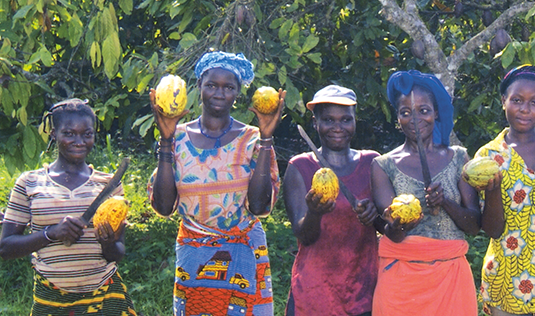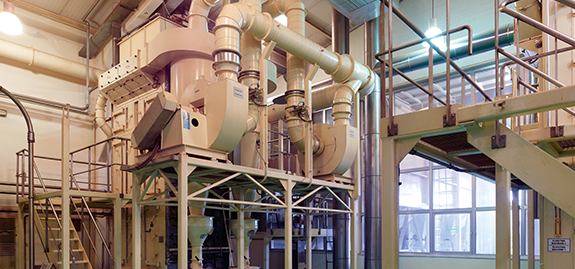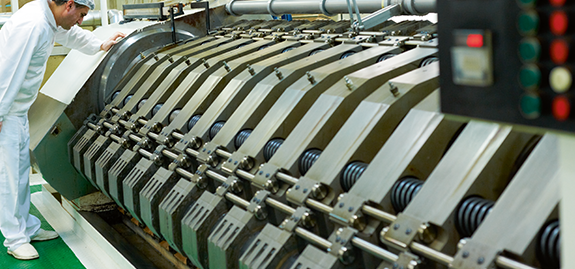PRODUCTION
THE PRODUCTION PROCESS
FROM COCOA POD TO
COCOA BEAN
Cocoa is the product of the fruit of the cocoa tree (lat. Theobroma cacao), which requires a hot, wet climate, a mean shade temperature of 27°C, and well-distributed rainfall. This is why it can only be grown in regions within 20º latitude of the Equator.
Although the cocoa tree is indigenous to Latin America, Africa today accounts for 70% of the world’s cocoa bean production. Cocoa farming is mostly manual, requiring significant expertise and most cocoa in Africa is grown on small family farms of 2-5 hectares. Next to the Ivory Coast and Ghana, other major cocoa producing countries are Nigeria, Cameroon, Indonesia, Papua New Guinea, Malaysia, Ecuador, Brazil and Colombia.
The cocoa is a very unusual looking tree, with yellow, green and red coloured fleshy fruit pods, about 25 cm long, hanging directly from its trunk and branches. The cocoa beans are embedded within a sticky, white, sweet tasting pulp. At harvest, the cocoa bean has to have reached the proper level of ripeness as under-ripe or over-ripe pods will have a negative impact on the bean’s cocoa flavour.
Raw cocoa beans are bitter and quite inedible. Two processes are required to turn the raw bean into the raw material for chocolate: fermentation and drying. Once the beans have been removed from the pods they are stacked, covered and left to ferment for 3-9 days. The process generates high temperatures of about 50ºC activating enzymes in the beans to form compounds that produce the chocolate flavour when the beans are roasted. The fermentation process must have been concluded properly. Too little fermentation and the desired cocoa taste does not develop fully, too much fermentation and undesirable “off tastes” develop.

After fermentation the beans are spread out on mats and usually left to dry in the sun for several days to keep them from spoiling. During drying, beans lose nearly all their moisture and more than half their weight. Finally, when the beans are dried, they are packed in 60-80 kg jute sacks for shipping.
 AFRICAN COUNTRIES SUCH AS THE IVORY COAST, GHANA, NIGERIA AND CAMEROON TODAY ACCOUNT FOR OVER 70% OF THE WORLD’S COCOA BEAN PRODUCTION.
AFRICAN COUNTRIES SUCH AS THE IVORY COAST, GHANA, NIGERIA AND CAMEROON TODAY ACCOUNT FOR OVER 70% OF THE WORLD’S COCOA BEAN PRODUCTION. FROM COCOA BEAN TO
COCOA LIQUOR
Cocoa mass is the liquid cocoa mass obtained after the roasting and grinding of the cocoa bean. (Despite its name, cocoa mass contains no alcohol whatsoever. It is also sometimes called “cocoa mass”.) The production process from cocoa bean to cocoa mass is as follows:
BLENDING, MIXING, CLEANING
Where different origin beans are required for a specific recipe, they are blended and mixed in right proportion and fed into the cleaning machine where all foreign bodies such as sand, dirt and stones are removed.
ROASTING
The first critical step in the industrial process is the roasting of the cocoa bean as the typical chocolate flavour is first created during roasting. (The raw cocoa bean has no chocolate flavour.) Roasting may be conducted before the shelling of the bean as well as after shelling (called “nib roasting”).
 BEANS MAY BE ROASTED BEFORE OR AFTER SHELLING.
BEANS MAY BE ROASTED BEFORE OR AFTER SHELLING. When the entire bean is roasted, the shell protects the cocoa “nib”, sealing aromatic oils. The amount of heat applied may vary according to the specific application. Low heat will dry the bean without roasting the inner nib. Some chocolates and cocoa recipes call for low-heat roasting. Alternatively, higher heat may be applied where darker colours and stronger roast flavours are required.
WINNOWING / SHELLING
Depending on the method used in each case, the beans are shelled before or after roasting, releasing the cocoa kernel or “nib” from the shell.
NIB ROASTING
Although roasting is mostly applied before shelling, some recipes call for nib roasting, resulting in darker hues and stronger flavours.

GRINDING
The cocoa nib consists of 52-56% cocoa butter. Together with the heat generated in the grinding process, the cocoa mass turns into the liquid “cocoa liquor”. Next to these standard processes, Altınmarka applies two additional critical processes at this stage: liquor flavour improvement and liquor refining - both of which have a significant impact on the quality of the final cocoa mass product.
COCOA LIQUOR FLAVOUR IMPROVEMENT
This process improves the microbiological profile of the cocoa mass and allows for the development of different colouring and flavour notes. This assists in the customization of the product and creates costs savings by reducing conching periods at the chocolate manufacturing stage.
COCOA LIQUOR REFINEMENT
This additional process improves product texture and ensures that the exact specified particle size required for a specific application and recipe is achieved. Once cocoa mass has been obtained, there are different routes this product can take: Further processing at Altınmarka’s chocolate plant Delivered in liquid form to clients in the chocolate, ice cream, confectionary and bakery manufacturing industries via Altınmarka’s dedicated high-tech, heated road tankers Packaged in 25-kg carton boxes and delivered to clients in solid form Further processing to obtain pure cocoa butter and cocoa powder
| Production Process |
| COCOA SOURCING | Cocoa Farming
Harvesting
Fermentation
Drying
Storage | Cocoa Bean |
| COCOA FARMING | Cocoa Production Process
Blending, Feeding, Cleaning
Roasting
Winnowing/Shelling
(Nib Roasting)
Grinding
Liquor Flavour Improvement
Liquor Refinement
Liquid Shipping or Packaging | Cocoa Liquor |
Cocoa Butter
Pressing (and deodorizing)
Liquid Shipping or Packaging
Cocoa Powder
Grinding (and alkalization)
Packaging | Cocoa Butter (natural or deodorized)
Cocoa Powder (natural or alkalized) |
| COCOA BEAN | Chocolate Production
Mixing
Pre-refining
Refining
3-stage Conching
(Liquid shipping) | Liquid Chocolate Mass |
Tempering
Moulding
Packaging | Chocolate Couverture,
Decorations and Inclusions |

FROM COCOA LIQUOR TO
COCOA BUTTER AND COCOA POWDER
PRESSING
When cocoa mass is subjected to high pressure inside hydraulic presses, the liquid fat inside the liquor is separated from the cocoa solids. Called “cocoa butter”, this gold-coloured precious fat is separated from the cocoa solids for further use in the chocolate making process. It is also a highly valued ingredient in the cosmetics industry. Cocoa butter is either delivered in its natural state or subjected to a deodorization process, which removes all distinct odours and flavours. Cocoa butter can be delivered in liquid form inside heated direct delivery tankers or packaged in 25-kg carton boxes with plastic lining. (Cocoa butter turns into to an off-white solid mass when cooled.)
CRUSHING, COOLING, GRINDING
On the other side of the hydraulic presses, flat “cocoa press cakes” consisting of dry cocoa solids are obtained from the cocoa mass. These cakes are first crushed, then cooled and then ground to produce fine cocoa powder. By adjusting the pressure levels inside the hydraulic presses, the cocoa butter content can be varied for different cocoa powder applications (10-12%, 12-20%, 20-22%).The cocoa powder can be used in its natural form or alkalized (also called “Dutched”) to produce darker shades with a stronger taste and improved solubility. Natural or alkalized cocoa powders are packaged and delivered 25-kg kraft paper bags for bulk use.
 COCOA BUTTER AND COCOA POWDER ARE OBTAINED FROM COCOA LIQUOR.
COCOA BUTTER AND COCOA POWDER ARE OBTAINED FROM COCOA LIQUOR. FROM COCOA LIQUOR TO
LIQUID CHOCOLATE
The chocolate-making process starts with cocoa mass, which is then mixed according to the client’s specific recipe and application with other ingredients. In principle, cocoa liquor is mixed with cocoa butter, sugar, milk powder (for milk chocolate) and emulsifiers. For white chocolate only cocoa butter, sugar and milk powder are used. At Altınmarka, the full process - from the blending of ingredients, to refining and conching is fully automated and computer-controlled to guarantee reliable, perfect results each time. Our production process is as follows:
MIXING
All dry ingredients, i.e. sugar, milk powder and other flavour ingredients are mixed and thoroughly combined with the liquid ingredients, according to the recipe’s specifications.
PRE-REFINING
The mixture first goes through the pre-refining machine where it is ground smooth.
REFINING
The mixture then travels through 5-roller cylinders, which press the mixture until it turns from a doughlike consistency to a dry powder.
CONCHING
Conching is a critical process that develops the chocolate’s flavour through a kneading process that can last from a few hours to several days, depending on the recipe and application and is performed inside hightech conches. The product goes through three separate conching stages for maximum quality. After conching is completed, the liquid chocolate mass is stored in stainless steel tanks heated to approx. 45°C for final processing or delivery.
FROM LIQUID CHOCOLATE TO
FINISHED CHOCOLATE PRODUCT
After conching is completed, the liquid chocolate is either sent to storage tanks for delivery in liquid form or is passed on to the tempering and moulding process lines to produce couverture chocolate or chocolate inclusions and decorations.
TEMPERING
Tempering is a carefully controlled process whereby the chocolate is subjected to a heating, cooling and reheating process. This reduces the size of the cocoa butter crystals and gives shiny surface and snap effect.
MOULDING
The chocolate is now ready for moulding according to the client’s applications. At Altınmarka we supply couverture in the shape of 2.5 and 5 kg chocolate blocks and chocolate coins. We also produce a range of chocolate drops, chunks, rolls etc. for inclusion or decoration purposes.
PACKAGING
Top quality, appropriate packaging materials and systems are used throughout to package the chocolate product in a range of practical package sizes for easy storage, delivery and use. At delivery, smaller packages are shrink wrapped into larger batches to ensure that all products arrive in perfect condition. Altınmarka also offers specialized, tailor-made packaging solutions.
SPECIALIST CERTIFICATION
At Altınmarka we can also manufacture products in conformity with special legislation, religious rules, directives and regulations.